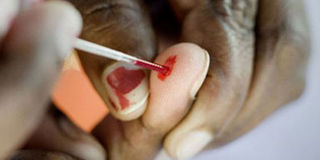Kenya makes huge gains in war on HIV but more challenges ahead

This file picture shows a person taking a HIV test. Kenya’s war against HIV/Aids has been rated one of the best in the world. Photo | FILE
What you need to know:
- Country has achieved an estimated anti-retroviral treatment coverage of 81 per cent
- Many of the targets set five years ago have been met although there is still need for a strong national institution that will co-ordinate the work of smaller agencies in the counties
Kenya’s war against HIV/Aids has been rated one of the best in the world in a new report to be launched Monday.
The report by an independent team recruited to find out how the county tackled challenges posed by the disease over the past five years said Kenya’s efforts towards reducing infections, putting HIV-infected people on treatment and encouraging more people to be tested for the virus was “exceptional”.
The eight-member team, led by a Ghanaian scholar, Prof Nana Poku, said the country’s success in encouraging voluntary male circumcision was a global pace-setter and had helped the country to achieve 80 per cent of the targets it set five years ago.
However, the report said the country needed to focus more on prevention of new infections in its next master-plan expected to come to force this year.
At the time of conducting the review, the report said, Kenya had achieved an estimated anti-retroviral treatment coverage of 81 per cent.
“This represented a more than 60-fold increase in the number of people accessing treatment since 2003,” said the
The proportion of people tested for HIV, the report said, had increased from 34 per cent in 2007 to 72 per cent in 2012, indicating that the number of people being tested had more than doubled in the five years.
Among those testing, the majority (56 per cent) had been tested in the previous 12 months.
The report also said that 67 per cent of those tested had done so more than once in their lifetime.
However, it showed that only 35 per cent had ever been tested for HIV together with their sexual partners.
The report also said the country achieved its target for voluntary medical male circumcision.
Much of this target came after the campaign was accepted in Nyanza region, where the Luo Council of Elders approved the strategy.
Since 2008, 63 per cent of the approximately 800,000 targeted men have been circumcised in Nyanza and Nairobi.
This raised the national voluntary male circumcision prevalence in 2012 to 91 per cent nationally.
According to the report, the American government under the Total War against Aids spent, Sh4.4 billion on 10,712 small projects with local organisations during the five years under review.
Other major development partners included (US) President’s Emergency Plan for Aids Relief (Pepfar), World Bank, UNAids, Global Fund and Jica.
The report said an estimated 1.7 million Kenyans had died of Aids-related complications since the first case was reported in Kenya in 1984.
But it noted that Aids-related deaths had dropped by two thirds — from 130,000 annually in 2002-2004 to 49,126 in 2011.
The report calls for strengthening of the National Aids Control Council to enable it provide “strong coordination mechanisms” under the devolved system.
But it noted there was a problem in allocation of money to different areas of the HIV response.
There were parallel financing systems with little coordination among donors, the report said.
“The domestic financing mechanisms remain highly inadequate while high costs of HIV/Aids commodities, and declining international commitment and resources for HIV and Aids have become threats to the national response,” it said.




